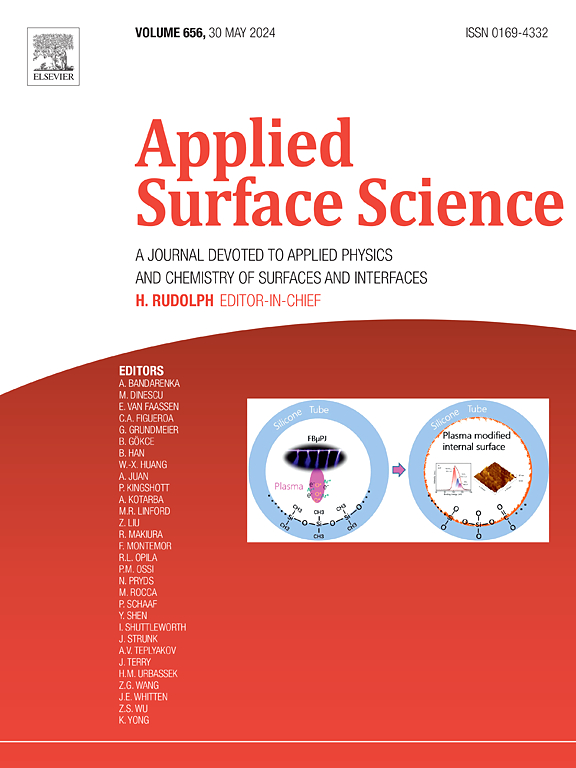用于去除金属铌表面化学残留物的分步控制超精密化学蚀刻技术
IF 6.3
2区 材料科学
Q2 CHEMISTRY, PHYSICAL
引用次数: 0
摘要
这项研究提出了一种高度精确的化学蚀刻工艺,旨在对铌(Nb)表面氧化层的形成和去除进行可控调节。角度分辨 X 射线光电子能谱(ARXPS)结果表明,经 HNO3 处理后,表面的饱和氧化层厚度超过 3 纳米。扫描电子显微镜(SEM)和 X 射线光电子能谱(XPS)结果表明,随着在 HNO3 和 HF 中处理时间的延长,铌表面化学残留物的去除效率显著提高。利用三维光学轮廓仪进行的详细表面分析表明,这种方法能够在不影响铌表面平整度的情况下实现均匀蚀刻,同时有效去除化学残留物。电化学稳定性测量和维氏硬度测试表明,循环蚀刻对铌的机械性能影响极小,而表面氧化层的自修复特性则保持了其化学稳定性。这种方法不仅推进了铌的精密蚀刻,还为其在表面完整性和化学复原力至关重要的高性能材料中的应用提供了可能。本文章由计算机程序翻译,如有差异,请以英文原文为准。

Step-controlled ultra-precise chemical etching for removing chemical residues from metallic niobium surfaces
This work presents a highly precise chemical etching process designed to achieve controlled modulation of the formation and removal of the oxide layer on the surface of niobium (Nb). Angle-resolved X-ray photoelectron spectroscopy (ARXPS) results indicate that the surface attains a saturated oxide layer thickness above 3 nm following treatment with HNO3. Scanning electron microscopy (SEM) and X-ray photoelectron spectroscopy (XPS) results show that the removal efficiency of chemical residue on the Nb surface significantly improves with increased treatment time in HNO3 and HF. A detailed surface analysis with a 3D optical profiler demonstrates that this method enables uniform etching without compromising the surface flatness of Nb while effectively removing the chemical residues. Electrochemical stability measurements and Vickers hardness tests reveal that cyclic etching exerts minimal impact on the mechanical properties of Nb, while the self-healing characteristics of the surface oxide layer maintain its chemical stability. This method not only advances precision etching for Nb but also opens up the potential for its application in high-performance materials where surface integrity and chemical resilience are paramount.
求助全文
通过发布文献求助,成功后即可免费获取论文全文。
去求助
来源期刊

Applied Surface Science
工程技术-材料科学:膜
CiteScore
12.50
自引率
7.50%
发文量
3393
审稿时长
67 days
期刊介绍:
Applied Surface Science covers topics contributing to a better understanding of surfaces, interfaces, nanostructures and their applications. The journal is concerned with scientific research on the atomic and molecular level of material properties determined with specific surface analytical techniques and/or computational methods, as well as the processing of such structures.
 求助内容:
求助内容: 应助结果提醒方式:
应助结果提醒方式:


